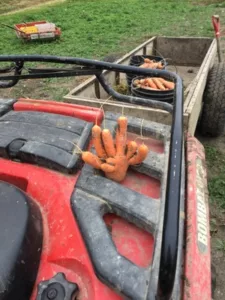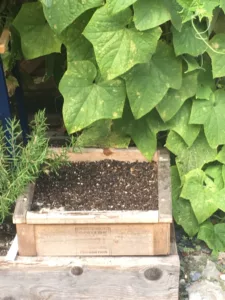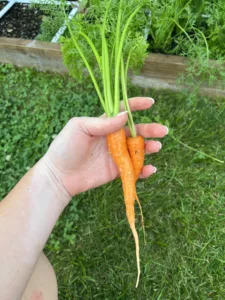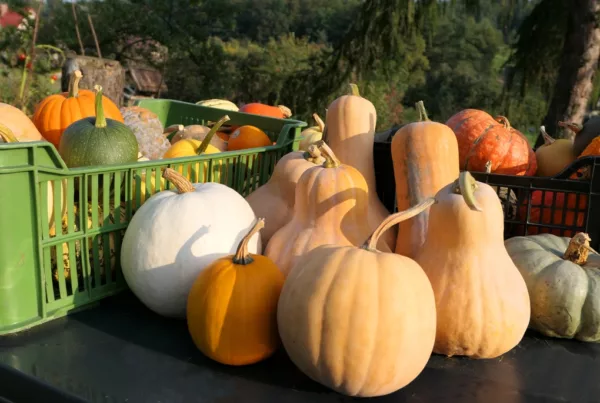Written by Kristina Hicks-Hamblin
 After properly sowing seeds, watering, and caring for your vegetable crops all season long, harvest time is now here – and you are met with the startling surprise of deformed carrots.
After properly sowing seeds, watering, and caring for your vegetable crops all season long, harvest time is now here – and you are met with the startling surprise of deformed carrots.
Once you’re done laughing at these wonky veggies, you might start wondering what causes these twisted, deformed, knobby, or just down right weird looking roots.
In the Square Foot Garden, there’s one reason in particular that this may happen – and when you learn what that reason is, it’s easy to prevent!
Banish Deformed Carrots with the Right Varieties

Deformed roots can be caused by growing varieties too long for the raised bed.
If you follow the SFG Method, your raised bed is likely six inches tall – but some carrot varieties are longer than six inches. Do you see the problem?
One of the main reasons for deformed carrots is that when their growing roots meet obstacles of any kind, they may produce extra growing tips, grow around the obstructions, or even try to take a U-turn!
This results in roots that aren’t the straight, pointy ones you were expecting.
In the SFG, the landscaping fabric at the bottom of the raised bed may turn into an obstacle that creates wonky roots. Any other resistant surface situated below the bed can also be problematic, including cardboard, patio concrete, or hard packed soil.
There are a couple of solutions to this problem.
One option is to choose carrot varieties that are shorter than six inches long, such as ‘Short Stuff’ (four to five inches long), ‘Little Finger (three to four inches long) (both available at Renee’s Garden), or ‘Tonda di Parigi’ (one to two inches long.)
Make Room for Long Carrots with a Top Hat

A top hat ready to be planted.
I mentioned there were two solutions – here’s the other: if you’re set on growing long rooted varieties, add a top hat to your raised bed!
A top hat is a twelve-by-twelve-inch, mini square foot bed which is used to add depth to a single grid section of a raised bed.
Put it in place, fill it with Mel’s Mix, and you’re ready to sow.
Then you’ll have close to twelve inches of depth to grow long carrot varieties – or daikon radishes or potatoes for that matter!
Other Causes for Crazy Carrots
While space restrictions are the most likely problem in the SFG bed, they aren’t the only cause for deformed carrots – if only gardening were that easy!
There are a few other factors that may be at play in your raised bed garden:
-

Straight roots are easy to grow when you follow the SFG Method!
When preparing your Mel’s Mix, make sure to mix in the compost so that there are no big clods. Clumps of compost can create obstacles too.
- In the SFG Method, this crop is grown 16 per square, and is sown at the rate of two to three seeds per hole. (More than one seed is sown per hole to make up for imperfect germination rates.) If you sow more than two to three seeds, the roots will be overcrowded and can twist around each other.
- Did you transplant seedlings instead of sowing seeds? The delicate taproots of these plants don’t transplant well – it’s best to sow these seeds directly onto the Mel’s Mix.
- Root knot nematodes, a type of pest, can also be to blame. You may notice wilting plants or yellowing foliage when these pests are present but check the roots – if root knot nematodes are a problem, you’ll find galls on them. Remove and dispose of any infected plants and be sure to rotate crops.
- Aster yellows, a plant disease, can also cause misshapen roots. Look for overly bushy or deformed looking foliage. Remove any infected plants and toss them out – don’t put pest infested or disease infected garden waste into your home compost pile.
As noted, most of these problems are avoided when following the guidelines offered by the SFG Method – a way to garden that offers food security right outside your backdoor!



